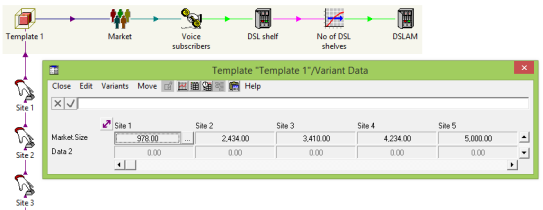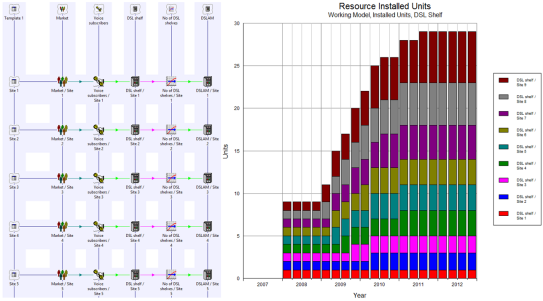Modelling demand for the fixed-access network at just one site is not very challenging: the complexity arises from varying characteristics across multiple sites, and considering the interconnections between them. STEM’s built-in deployment feature allows you to express the fact that a single demand is spread over one or more physically separate sites, and this is what drives the WiMAX upgrade path described above on a macro-economic basis, without modelling each site in turn.
A similar approach could be used to model the deployment of DSL across multiple exchange sites in a region; but suppose we do have access to specific market size data at a per-site level, and possibly even different penetration growth curves. Although we could run the model over and over for each site in turn, this would not be very practical for a detailed scenario or sensitivity analysis, nor would it give you results for the network business as a whole.
STEM provides a template replication feature which allows you to repeat the same model structure many times within one model without having to manually replicate any of the model structure. First you group the elements in question as a template, and then you identify the inputs within that template which should vary by site. STEM automatically creates a table with one row per input and one column per site, and allows you to just type in the varying values without repeating the entire calculation structure, ensuring consistency of calculation and results across all sites.

Figure 1: Template elements and variant data
Although manual replication is feasible with STEM’s intelligent copy-and-paste function, this approach is labour-intensive, subject to user error, and does not help much if you want to add something to the calculation structure later. In contrast, template replication allows you to identify template elements which will then be replicated automatically whenever you re-run the model. This means that any new structure added to the template will be automatically propagated across all sites.
Detailed and consistent results are generated for each individual site, as well as for the network as a whole. When you proceed to add scenarios or sensitivities, you are guaranteed that these will impact equally on all sites. The further you go with this sort of analysis, the harder it gets to keep everything consistent in a spreadsheet, whereas STEM is purpose-built with this kind of process automation in mind.

Figure 2: Automatically replicated template elements and results